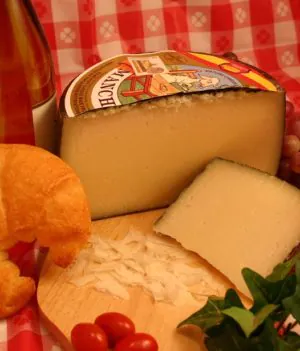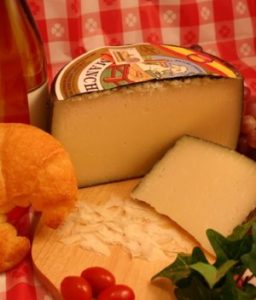Tag: Manchego Cheese
Manchego Cheese: Everything you Need to Know
What is Manchego Cheese?
Manchego is a sheep’s milk cheese from Spain. The shape of Manchego cheese is very characteristic and defined. It has an intense taste and crumbly texture which makes it perfect for eating alone. It has a rich golden color and small holes.
It is traditionally made with grass molds so it has a very distinctive zigzag pattern on the cheese. It appears as a herringbone pattern n the rind, which is inedible.
How is Manchego cheese aged?
The rich, semi-firm product is aged in natural caves for two to six months, giving it a zest and exuberant flavor. It is always aged for a minimum of two months.
There are significant changes in the flavor over time and sometimes in Spain, you will see it served in a variety of ages.
History of Manchego Cheese
Manchego cheese is made in the La Mancha region of Spain. It has a long historical and literary tradition, as it was mentioned by Cervantes in the legendary “Don Quixote of La Mancha”.
It is made from the whole milk of the Manchega sheep, which are only bred in the La Mancha region. Archaeological remains show that a cheese like Manchego may have been made as far back as the Bronze Age.
What does it taste like?
It has a caramel, nutty flavor with some acidity. The longer it is aged, the more the flavor resembles butterscotch.
How should I eat it?
Manchego is a great cheese for eating on its own or as part of a cheese board. It pairs beautifully with fruits such as figs and plums. It’s also delicious with fruity chutneys.
Membrillo, a quince paste, is often served with Manchego Cheese as the textures and flavors create a great contrast.
It’s also great with savory flavors such as olives, sundried tomatoes, and crusty bread.
It also grills well so it can be delicious in a grilled cheese or grated over baked pasta dishes instead of parmesan. We love it in quesadillas with some spicy chorizo.
If you are serving a tapas dinner, a block of manchego is a great addition to the table. Add some bread and a bottle of red wine – you’ll keep all your guests happy.
What should I drink with Manchego Cheese?
It pairs well with a robust red wine such as Rioja or Tempranillo. It is also delicious with a glass of dry sherry.
The aromatic intensity of a Manzanilla wine also makes it an excellent foil for Manchego cheese.
Have you tried Manchego? How do you like to eat it? Let us know in the comments!
Manchego Cheese: A True Taste of Spain

If you go to the La Mancha region in central Spain, home to the famous Don Quixote, you’ll have the pleasure of tasting queso Manchego, or Manchego cheese. Of course, you can sample this cheese in other parts of the country, and even abroad, but there is nothing like nibbling on the real thing in the land of its origin.
This cheese, which is made from sheep’s milk, and aged no less than 60 days, has got a lot of history behind it. Archeological digs have turned up evidence suggesting that this very unique cheese was being made well before the time of Christ. One of the main purposes of making cheese in the past was to persevere the milk and the health benefits derived from dairy, since refrigeration wasn’t available at the time.
These days, only very special ewes (female sheep) are used in the Manchego cheese making process. The queso is actually protected by the Spanish Government with a ‘Denominación de Origen,’ which means only certain cheeses can be labeled as Manchego cheese. For this tasty and buttery cheese to be called ‘Manchego,’ it has to come from La Mancha. Only the fatty milk from authentic Manchega ewes, which are descended from sheep that have been roaming these lands for centuries, can be used to create the cheese. And the cheese itself must be aged in local caves.
The technical cheese making process consists of milking the ewes by hand, and then putting the milk in curdling vats, where natural curdling enzymes are added to the mix. Then the cheese curd is sliced up into tiny bits and aged. If you ask any of the locals what is the most important aspect in making Manchego cheese, you’re sure to get different answers, but aging the cheese, and the special nature of Manchega ewes will be sure to top the list.
If all of the above requirements are met, you still have a choice between classic Manchego cheese that comes from unpasteurized milk, and the kind that comes from pasteurized milk. In addition to these basic distinctions, you can also select quesos of different ages. Manchego cheese is well-known for its creamy texture, but the flavor varies between the semi-cured Manchego Curado and the richer Manchego Viejo. There is even a fresh cheese, Manchego Fresco, you can buy and sample before it has completed the aging process. The best thing for you to do is to head to La Mancha and try all of these wonderful cheeses for yourself.
PURE PROTEIN
 We all know that a good cheese is a very complete food, a real concentrate of all the fine nutritional qualities of milk.
We all know that a good cheese is a very complete food, a real concentrate of all the fine nutritional qualities of milk.
Today I found out that Manchego cheese actually has such a high proportion of proteins that is in fact even richer in proteins than meat! That’s great news for all the veggies out there.
Proteins are the building blocks of life. The body needs protein to repair cells and make new ones. Furthermore, protein is also important for growth and development during childhood, adolescence, and pregnancy (and Manchego is a safe cheese for a preggo to eat!).
So now you know, next time you fancy some Manchego, stop feeling guilty about it. Yes, it might be rich in calories, but it’s good for you too!
LOW IN LACTOSE
 According to recent studies, more than 40 Million Americans are lactose intolerant.
According to recent studies, more than 40 Million Americans are lactose intolerant.
Like all hard cheeses, Manchego is naturally low in lactose. Additionally, being made with sheep’s milk – which has a lower percentage of lactose than cow’s milk – makes it more suitable for sensitive stomachs.
Furthermore, as the longer a cheese is aged the less lactose it has, and Manchego can be aged for up to 2 years, lactic sensitive people have the perfect alibi to reach for the most exquisite of all Manchegos: the most aged ones.
THOUSANDS OF YEARS IN THE MAKING
Manchego is one of the world’s cheeses with the most valuable history and heritage. That’s a well-known fact.
But, did you know that Pre-Historic men and women already enjoyed the pleasures of fine Manchego cheese?
Yes, as locals tell it, archeological remains dating back to the Bronze age show that the inhabitants of La Mancha used to make a sheep’s milk cheese with the milk of a race of sheep that’s considered the ancestor of our modern Manchega sheep. Weren’t they clever!
Of course, we don’t know what methods our ancestors used to make this natural product, but we could assume that their cheese tasted very much like ours, and that their cheesemaking methods were most probably similar too.
Next time you queue up to buy your Manchego think about those cave men & women who were already in the know. When a little pleasure survives the turn of so many centuries it must mean it’s worth passing it on!
HOW TO CUT MANCHEGO CHEESE
 Ok… so you bought a whole Manchego cheese. You are all excited about the great cheese you’ve got and can’t wait to start eating it.
Ok… so you bought a whole Manchego cheese. You are all excited about the great cheese you’ve got and can’t wait to start eating it.
Now you are home staring at the cheese and wondering what would be the best way to cut a wedge out of it without destroying the masterpiece.
Have you been there? If so, here’s how to do it properly in a few simple steps:
- Cut the cheese in two halves.
- Cut a wedge out of one the halves – You should only cut as much as you plan to eat.
- Take the bottom bit of rind off.
- Cut it into slices about 5mm (1/4”) thick.
- Serve – if possible – at room temperature. Manchego cheeses taste their best at 68°
Be sure to stop in at Shisler’s Cheese House and try some Manchego Cheese and enjoy a taste of Spain!





